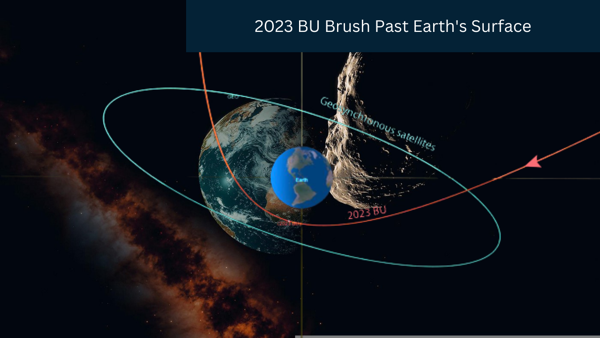
Science & Space
NASA's Asteroid Alert: 2023 BU, Earth's Closest Encounter With A Tiny Asteroid
That's fantastic! Huston, The bus-sized asteroid successfully brushes past Earth, marking the closest-ever approach ever recorded by NASA.
On the dusk of 27th January, the 2023 BU a near-earth object passed 9,967 kilometers from the center point of the earth, as the earth's radius is 6,378 kilometers, therefore, it passed approximately 3589 kilometers from the surface of the planet over the southern tip of South America, near Antarctica.
The passage of 2023 BU is even closer than some of the closest man-made objects in space.
It passed 2000 kilometers above lower earth objects and 36,000 kilometers below geostationary objects.
Its distance was 100 times closer than the moon, and 10 times closer than satellites in the geostationary orbit.
Today, the passing time of the object was 00:29 UTC (Coordinated Universal Time); 05:59 IST (Indian Standard Time).
The asteroid reached perihelion (the point closest to the sun in an orbiting celestial body's path) at 04:29UTC; 09:59 IST, four hours after its closest approach with Earth.
2023 BU was first imaged by "Gennadly Borisov" at Nauchnyi, Crimea, on 21st January 2023, at 23:53 UTC or 05:23 IST, about 6 days before the closest approach.
After the 2023 BU's first appearance in the sky, further observations were reported to the Minor Planet Center, a clearinghouse for the position measurement of small celestial bodies.
And after the proper discovery was announced, more and more astronomers and scientists pour into it to find more accurate data about the celestial objects.
Scout, NASA's impact hazard assessment system based in Southern California, analyzed all the input data from other sources and quickly predicted that the asteroid will miss the earth.
2023 BU was expected to take 359 days and follow the circular path to complete an orbit around the sun before its close encounter with the earth's gravity, but after its close encounter with the earth, its trajectory has been elongated and it will now take 425 days for one orbit.
The asteroid's diameter ranges from 4.5 to 9.5 meters, which could have resulted in an explosion in the sky and some injuries on Earth.
2023 BU is the fourth non-impacting object after 2020 VT, 2020 QG, and 2021 UA1.
2020 VT: Tiny near-earth asteroid passed 370 kilometers above the earth's surface on 13th November 2020. The asteroid was discovered by the Mauna Loa Observatory's Asteroid Terrestrial-impact Last Alert System (ATLAS) survey fifteen hours after its closest approach to Earth. The earth's gravity changes the earth's orbital time from 1.5 years to 0.86 years.
2020 QG: 2020 QG, also known as ZTF0DxQ, is a near-earth-crossing asteroid. The asteroid belongs to the Apollo group, and it passed the earth, 2,950 kilometers above the surface. On 16th August 2020, it brushed past the earth's surface.
2021 UA1: 2021 UA1 is a small (2 meter) near-Earth object that passed about 3047 kilometers above the Earth's surface on October 25, 2021, around 03:07 UTC while passing over Antarctica.
Every day, approximately 150 tonnes of material from space arrive on Earth, including celestial objects from the Kuiper belt and completely alien objects. Eart's encounters with smaller asteroids are a very common phenomenon, and eath's magnetic and atmospheric fields are completely capable of handling it.
But the scary part is, every 500,000 years, on average, a 1 km (0.62 mi) diameter star will strike Earth. Large collisions with 5 km (3 mi) objects occur about once every twenty million years. An event like this causes the catastrophic annihilation of living organisms on earth, and that event happened 66 million years ago, known as the Cretaceous–Paleogene extinction event.


0 Comments